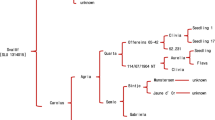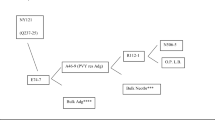Abstract
Seventy-two potato cultivars have been bred at the Scottish Plant Breeding Station and the Scottish Crop Research Institute since 1920. The original genetic base contained resistance to wart disease and to viruses, but not comprehensive resistance to all strains. Introgression of resistance genes from the wild and cultivated potato species of Latin America started for late blight in 1932, for viruses in 1941 and for potato cyst nematodes in 1952. Just seven of the 219 wild tuber-bearing species recognized by Hawkes in 1990 feature in the pedigrees of our cultivars, with Solanum demissum for blight resistance in 58, S. vernei for nematode resistance in 19 and S. microdontum for Potato virus Y resistance in 15, the other four species being S. multidissectum, S. commersonii, S. maglia and S. acaule. Resistance to other fungal and bacterial diseases has been mainly due to chance rather than deliberate breeding. From 1970, selection for yield and quality included processing quality, and despite lack of commercial success, prospects remain good for cultivars resistant to sweetening during cold storage. Since 1990 prebreeding has combined desirable traits through efficient recurrent selection based on progeny testing and provided parents for the commercially funded breeding of finished cultivars. Only one cultivar is a Neotuberosum–Tuberosum hybrid, whereas 15 cultivars have the H1 gene for resistance to Globodera rostochiensis introgressed from group Andigena. Long-day Phureja cultivars are finding a market niche for their flavour attributes. Breeding strategies and methods are critically reviewed from a genetic viewpoint.









Similar content being viewed by others
Abbreviations
- CPC:
-
Commonwealth Potato Collection
- NL:
-
National List
- PCN:
-
Potato cyst nematode
- PLRV:
-
Potato leafroll virus
- PMTV:
-
Potato mop-top virus
- PVX:
-
Potato virus X
- PVY:
-
Potato virus Y
- QTL:
-
Quantitative trait locus
- SCRI:
-
Scottish Crop Research Institute
- SPBS:
-
Scottish Plant Breeding Station
- SSRPB:
-
Scottish Society for Research in Plant Breeding
- TRV:
-
Tobacco rattle virus
References
Ames M, Spooner DA (2008) DNA from herbarium specimens settles a controversy about origins of the European potato. Am J Bot 95:252–257 doi:10.3732/ajb.95.2.252
Anonymous (2008) Potato yearbook & buyer’s guide. Act, Maidstone
Black W (1970) The nature and inheritance of field resistance to late blight (Phytophthora infestans) in potatoes. Am Potato J 47:279–288 doi:10.1007/BF02863003
Black W (1971) Researches on potatoes at the Scottish Plant Breeding Station. In: Scottish Plant Breeding Station fiftieth annual report 1970–71. Scottish Plant Breeding Station, Pentlandfield, pp 52–60
Bonierbale MW, Plaisted RL, Tanksley SD (1988) RFLP maps based on a common set of clones reveal modes of chromosomal evolution in potato and tomato. Genetics 120:1095–1103
Bradshaw JE (2007a) Potato-breeding strategy. In: Vreugdenhil D (ed) Potato biology and biotechnology. Advances and perspectives. Elsevier, Oxford, pp 157–177
Bradshaw JE (2007b) Breeding potato as a major staple crop. In: Kang MS, Priyadarshan PM (eds) Breeding major food staples. Blackwell, Oxford, pp 277–332
Bradshaw JE, Mackay GR (1994) Breeding strategies for clonally propagated potatoes. In: Bradshaw JE, Mackay GR (eds) Potato genetics. CAB International, Wallingford, pp 467–497
Bradshaw JE, Ramsay G (2005) Utilisation of the commonwealth potato collection in potato breeding. Euphytica 146:9–19 doi:10.1007/s10681–005–3881–4
Bradshaw JE, Stewart HE, Wastie RL, Dale MFB, Phillips MS (1995) Use of seedling progeny tests for genetical studies as part of a potato (Solanum tuberosum subsp. tuberosum) breeding programme. Theor Appl Genet 90:899–905 doi:10.1007/BF00222029
Bradshaw JE, Dale MFB, Swan GEL, Todd D, Wilson RN (1998) Early-generation selection between and within pair crosses in a potato (Solanum tuberosum subsp. tuberosum) breeding programme. Theor Appl Genet 97:1331–1339 doi:10.1007/s001220051026
Bradshaw JE, Lees AK, Stewart HE (2000a) How to breed potatoes for resistance to fungal and bacterial diseases. Plant Breed Seed Sci 44:3–20
Bradshaw JE, Todd D, Wilson RN (2000b) Use of tuber progeny tests for genetical studies as part of a potato (Solanum tuberosum subsp. tuberosum) breeding programme. Theor Appl Genet 100:772–781 doi:10.1007/s001220051351
Bradshaw JE, Dale MFB, Mackay GR (2003) Use of mid-parent values and progeny tests to increase the efficiency of potato breeding for combined processing quality and disease and pest resistance. Theor Appl Genet 107:36–42
Bradshaw JE, Pande B, Bryan GJ, Hackett CA, McLean K, Stewart HE, Waugh R (2004) Interval mapping of quantitative trait loci for resistance to late blight [Phytophthora infestans (Mont.) de Bary], height and maturity in a tetraploid population of potato (Solanum tuberosum subsp. tuberosum). Genetics 168:983–995 doi:10.1534/genetics.104.030056
Bradshaw JE, Hackett CA, Lowe R, McLean K, Stewart HE, Tierney I, Vilaro MDR, Bryan GJ (2006) Detection of a quantitative trait locus for both foliage and tuber resistance to late blight [Phytophthora infestans (Mont.) de Bary] on chromosome 4 of a dihaploid potato clone (Solanum tuberosum subsp. tuberosum). Theor Appl Genet 113:943–951 doi:10.1007/s00122–006–0353–8
Bradshaw JE, Hackett CA, Pande B, Waugh R, Bryan GJ (2008) QTL mapping of yield, agronomic and quality traits in tetraploid potato (Solanum tuberosum subsp. tuberosum). Theor Appl Genet 116:193–211 doi:10.1007/s00122–007–0659–1
Brown J, Dale MFB, Mackay GR (1996) General adaptability of potato genotypes selected in the UK for the Mediterranean region. J Agric Sci Camb 126:441–448
Cadman CH (1942) Autotetraploid inheritance in the potato: some new evidence. J Genet 44:33–52 doi:10.1007/BF02982766
Carroll CP (1982) A mass-selection method for the acclimatization and improvement of edible diploid potatoes in the United Kingdom. J Agric Sci Camb 99:631–640
Carroll CP (1987) The use of diploid Solanum phureja germplasm. In: Jellis GJ, Richardson DE (eds) The production of new potato varieties. Cambridge University Press, Cambridge, pp 231–234
Carroll CP, De Maine MJ (1989) The agronomic value of tetraploid F1 hybrids between potatoes of group Tuberosum and group Phureja/Stenotomum. Potato Res 32:447–456 doi:10.1007/BF02358500
Cockerham G (1970) Genetical studies on resistance to potato viruses X and Y. Heredity 25:309–348 doi:10.1038/hdy.1970.35
Cooke DEL, Lees AK, Shaw DS, Taylor MC, Prentice MWC, Bradshaw NJ, Bain RA (2008) The status of GB blight populations and the threat of oospores. Proc Crop Prot North Br 2008:217–222
Dale MFB, Mackay GR (1994) Inheritance of table and processing quality. In: Bradshaw JE, Mackay GR (eds) Potato genetics. CAB International, Wallingford, pp 285–315
Davidson TMW (1980) Breeding for resistance to virus disease of the potato (Solanum tuberosum) at the Scottish Plant Breeding Station. In: Scottish Plant Breeding Station fifty-ninth annual report 1979–80. Scottish Plant Breeding Station, Pentlandfield, pp 100–108
Friedman M (2003) Chemistry, biochemistry, and safety of acrylamide. A review. J Agric Food Chem 51:4504–4526 doi:10.1021/jf030204+
Gallie RJL (1971) The Society and the Station: an historical introduction. In: Scottish Plant Breeding Station fiftieth annual report 1970–71. Scottish Plant Breeding Station, Pentlandfield, pp 29–39
Glendinning DR (1981) Evaluate Neo-Tuberosum potatoes as parental material for use in breeding cultivars. Scott Crop Res Inst Annu Rep 181–183
Glendinning DR (1983) Potato introductions and breeding up to the early 20th century. New Phytol 94:479–505 doi:10.1111/j.1469–8137.1983.tb03460.x
Glendinning DR (1987) Neo-tuberosum. Scott Crop Res Inst Annu Rep 77–78
Goodwin SB, Drenth A (1997) Origin of the A2 mating type of Phytophthora infestans outside Mexico. Phytopathology 87:992–999 doi:10.1094/PHYTO.1997.87.10.992
Hackett CA, Milne I, Bradshaw JE, Luo Z (2007) TetraploidMap for Windows: linkage map construction and QTL mapping in autotetraploid species. J Hered 98:727–729 doi:10.1093/jhered/esm086
Hawkes JG (1990) The potato: evolution, biodiversity & genetic resources. Belhaven, London
Haynes KG, Lu W (2005) Improvement at the diploid species level. In: Razdan MK, Mattoo AK (eds) Genetic improvement of solanaceous crops, vol I: potato. Science, Enfield, pp 101–114
Holden JWH (1977) Potato breeding at Pentlandfield. In: Scottish Plant Breeding Station fifty-sixth annual report 1976–77. Scottish Plant Breeding Station, Pentlandfield, pp 66–97
Hougas RW, Peloquin SJ, Ross RW (1958) Haploids of the common potato. J Hered 49:103–107
Killick RJ, Malcolmson JF (1973) Inheritance in potatoes of field resistance to late blight [Phytophthora infestans (Mont.) de Bary]. Physiol Plant Pathol 3:121–131 doi:10.1016/0048–4059(73)90028–3
Love SL, Pavek JJ, Thompson-Johns A, Bohl W (1998) Breeding progress for potato chip quality in North American cultivars. Am J Potato Res 75:27–36
Lunden AP (1937) Arvelighetsundersokelser i potet (Inheritance studies in the potato). Meld Nor Landbrukshoishk 17:1–156
Mackay GR (1987) Selecting and breeding for better potato cultivars. In: Abbot AJ, Atkin RK (eds) Improving vegetatively propagated crops. Academic, London, pp 181–196
Mackay GR (2003) Potato breeding at SCRI during the last quarter of the 20th century. Scott Crop Res Inst Annu Rep 2001/2002 83–92
Mackay GR (2005) Propagation by traditional breeding methods. In: Razdan MK, Mattoo AK (eds) Genetic improvement of solanaceous crops, vol I: potato. Science, Enfield, pp 65–81
Malcolmson JF (1969) Races of Phytophthora infestans occurring in Great Britain. Trans Br Mycol Soc 53:417–423
Malcolmson JF (1976) Assessment of field resistance to blight (Phytophthora infestans) in potatoes. Trans Br Mycol Soc 67:321–326
Rios D, Ghislain M, Rodriguez F, Spooner DM (2007) What is the origin of the European potato? Evidence from Canary Island landraces. Crop Sci 47:1271–1280
Salaman RN (1921) Degeneration of potatoes. Report on the International Potato Conference. Royal Horticultural Society, London, pp 79–91
Simmonds NW (1969) Prospects of potato improvement. In: Scottish Plant Breeding Station forty-eighth annual report 1968–69. Scottish Plant Breeding Station, Pentlandfield, pp 18–38
Simmonds NW (1971) Report by the Director: potato investigations. In: Scottish Plant Breeding Station fiftieth annual report 1970–71. Scottish Plant Breeding Station, Pentlandfield, pp 6–19
Simmonds NW (1972) Report by the Director: potato investigations. In: Scottish Plant Breeding Station fifty-first annual report 1971–72. Scottish Plant Breeding Station, Pentlandfield, pp 6–15
Simmonds NW (1981) Genotype (G), environment (E) and GE components of crop yields. Exp Agric 17:355–362 doi:10.1017/S0014479700011807
Solomon-Blackburn RM, Bradshaw JE (2007) Resistance to Potato virus Y in a multitrait potato breeding scheme without direct selection in each generation. Potato Res 50:87–95 doi:10.1007/s11540–007–9031–8
Solomon-Blackburn RM, Stewart HE, Bradshaw JE (2007) Distinguishing major-gene from field resistance to late blight (Phytophthora infestans) of potato (Solanum tuberosum) and selecting for high levels of field resistance. Theor Appl Genet 115:141–149 doi:10.1007/s00122–007–0550–0
Solomon-Blackburn RM, Nikan J, Barker H (2008) Mechanism of strong resistance to Potato leafroll virus infection in a clone of potato (Solanum tuberosum). Ann Appl Biol 152:339–347 doi:10.1111/j.1744–7348.2008.00223.x
Stewart HE, Bradshaw JE, Wastie RL, Mackay GR, Erlich O, Livescu L, Nachmias A (1994) Assessing progenies of potato for resistance to early blight. Potato Res 37:257–269 doi:10.1007/BF02360518
Stewart HE, Bradshaw JE, Pande B (2003) The effect of the presence of R-genes for resistance to late blight (Phytophthora infestans) of potato (Solanum tuberosum) on the underlying level of field resistance. Plant Pathol 52:193–198 doi:10.1046/j.1365–3059.2003.00811.x
Tarn TR, Tai GCC (1983) Tuberosum x Tuberosum and Tuberosum x Andigena potato hybrids: comparisons of families and parents, and breeding strategies for Andigena potatoes in long-day temperate environments. Theor Appl Genet 66:87–91 doi:10.1007/BF00281854
Van der Plank JE (1968) Disease resistance in plants. Academic Press, London
Wastie RL (1991) Breeding for resistance. In: Ingram DS, Williams PH (eds) Phytophthora infestans, the cause of late blight of potato. Advances in plant pathology, vol 7. Academic Press, London, pp 193–224
Wilkinson MJ (1992) The partial stability of additional chromosomes in Solanum tuberosum cv. Torridon. Euphytica 60:115–122
Acknowledgements
Funding from the Scottish Government (Rural and Environment Research and Analysis Directorate) is gratefully acknowledged, as are discussions on potato breeding over many years with colleagues, particularly George Mackay and Finlay Dale.
Author information
Authors and Affiliations
Corresponding author
Rights and permissions
About this article
Cite this article
Bradshaw, J.E. Potato Breeding at the Scottish Plant Breeding Station and the Scottish Crop Research Institute: 1920–2008. Potato Res. 52, 141–172 (2009). https://doi.org/10.1007/s11540-009-9126-5
Received:
Accepted:
Published:
Issue Date:
DOI: https://doi.org/10.1007/s11540-009-9126-5




